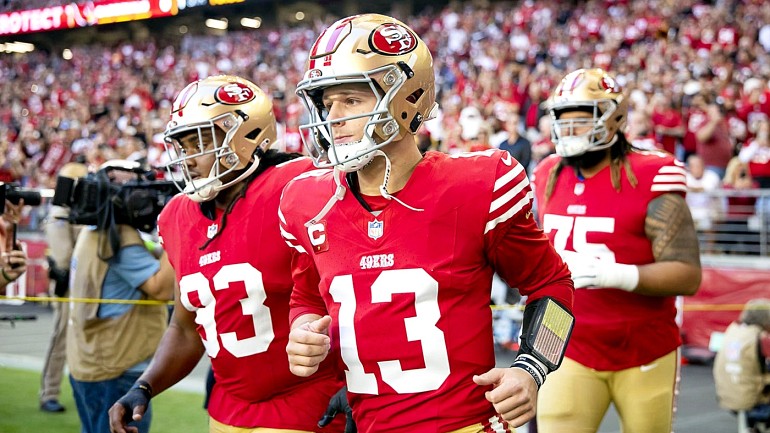Ball control sought as its primary goal the physical domination of the opposition. In college, those teams with superior talent, say the Ohio State Buckeyes under Woody Hayes, could simply grind away behind behemoth linemen, and gradually wear opponents down. In the pros, Lombardi's Packers became notorious for utilizing the ball-control formula to such an extent that, even today, when fans discuss the greatest quarterback of all time, they often omit Bart Starr, even though the classic-sixties Packers' field general has both the stats and championships to merit inclusion in that discussion. In 1972, the Miami Dolphins, ball-control masters, went undefeated.
Of course nothing stays monolithic forever, and exceptions always abound. The Pittsburgh Steelers of the seventies, for instance, started out as defense-and-running-game mashers, then transitioned later in the decade to more of a passing team. Concurrently, Bill Walsh, having learned the vertical passing game from Sid Gilman, Al Davis, and Paul Brown, began to implement his own version of it, first at Stanford University during 1977-78, and, subsequently, as head coach of the San Francisco 49ers. Walsh, along with myriad other innovations, developed a ball-control passing game that exploited defenses still designed primarily to stop the run.
As, in the wake of Walsh, the new passing game proliferated, some wags dubbed the old ball-control offense "three yards and a cloud of dust," and disparaged its boredom. To demur: First, a well-blocked running play, very difficult to execute, remains one of the NFL's aesthetic glories. Second, no offensive coach wanted just three yards per play. Give them 3.4 yards, minimum, to pick up some first downs, with fewer punts. Third, even Vince Lombardi himself promoted a "run to daylight" philosophy, designed not for just three yards, but for larger chunks.
Most football coaches will tell you that nothing new exists under the gridiron sun, and that, though we may sometimes think we see something fresh, no doubt some team, somewhere, in some other era, tried it first. So, other examples may well do, but I prefer, for obvious reasons, to use one from 49er history: the implementation, from 1992 to 1994, of the strategic running game by then-offensive-coordinator Mike Shanahan.
Mr. Shanahan joined the 49ers soon after the equally strong-willed Al Davis relieved him of his duties as Raiders head coach. George Seifert, a former defensive coordinator, coached the Niners then, and, biased toward game-control tactics, constantly fought himself to keep from meddling, mid-game, with the offense, as defense-first coaches sometimes do. So, Shanahan risked another possible clash with yet another boss. Shanahan, after all, during this, the heyday of Steve Young, John Taylor, Jerry Rice, et al, had offensive weapons, and, understandably, wanted to use them. Eventually, he did, as Seifert, to his credit, learned to trust the creativity of his young assistant. Shanahan, for his part, partially mollified his head coach by extending that creativity to, yes, the running game.
Mike Shanahan took his strategic running game with him to his next job as head coach of the Denver Broncos. There, he earned the reputation as a running-game guru. Repeatedly, his offensive system took late-round-draft-choice backs and turned them into thousand-yard rushers. Last season, with Washington, he accomplished the same feat with sixth-rounder Alfred Morris. Shanahan bases his running game on zone-blocking principles. This requires that his linemen think on their feet and make adjustments on the fly. His running backs, for their part, must read the blocking, make one cut, and then burst up the field. Backs who "dance" too much at the point of attack, particularly those who succeeded with this do-si-doing in college, face ruder partners in the NFL. Shanahan, at minimum, wants five yards a pop, thereby securing first downs with two running plays. He does not want backs to lose yardage.
In other words, Shanahan does not use the running game for ball control only, or just to "keep the defense honest" between passing plays, though, in the event, it may accomplish both these purposes too. No, he wants bigger bunches of yardage from his running game. He doesn't intend merely to grind you. He intends to gash you.
A couple more points before moving on to today's Niners. (1) Strategic running differs slightly from purely situational running. Situational running adheres more closely to down/distance/field-position necessities, for instance first-and-goal at the one yard-line. In contradistinction, Shanahan's strategic running, particularly on early downs between the twenties, seeks to compete with contemporary passing-game juggernauts, not just by attempting to pile up first downs, although that's nice work, too, if you can get it, but by increasing the possibilities for big plays down the field. (2) Shanahan's offense continues to evolve, and got a massive injection of firepower last year, fueled by the exceptional talents of Robert Griffin III. The Redskins now not only take advantage of cavities in defenses; they create them.



